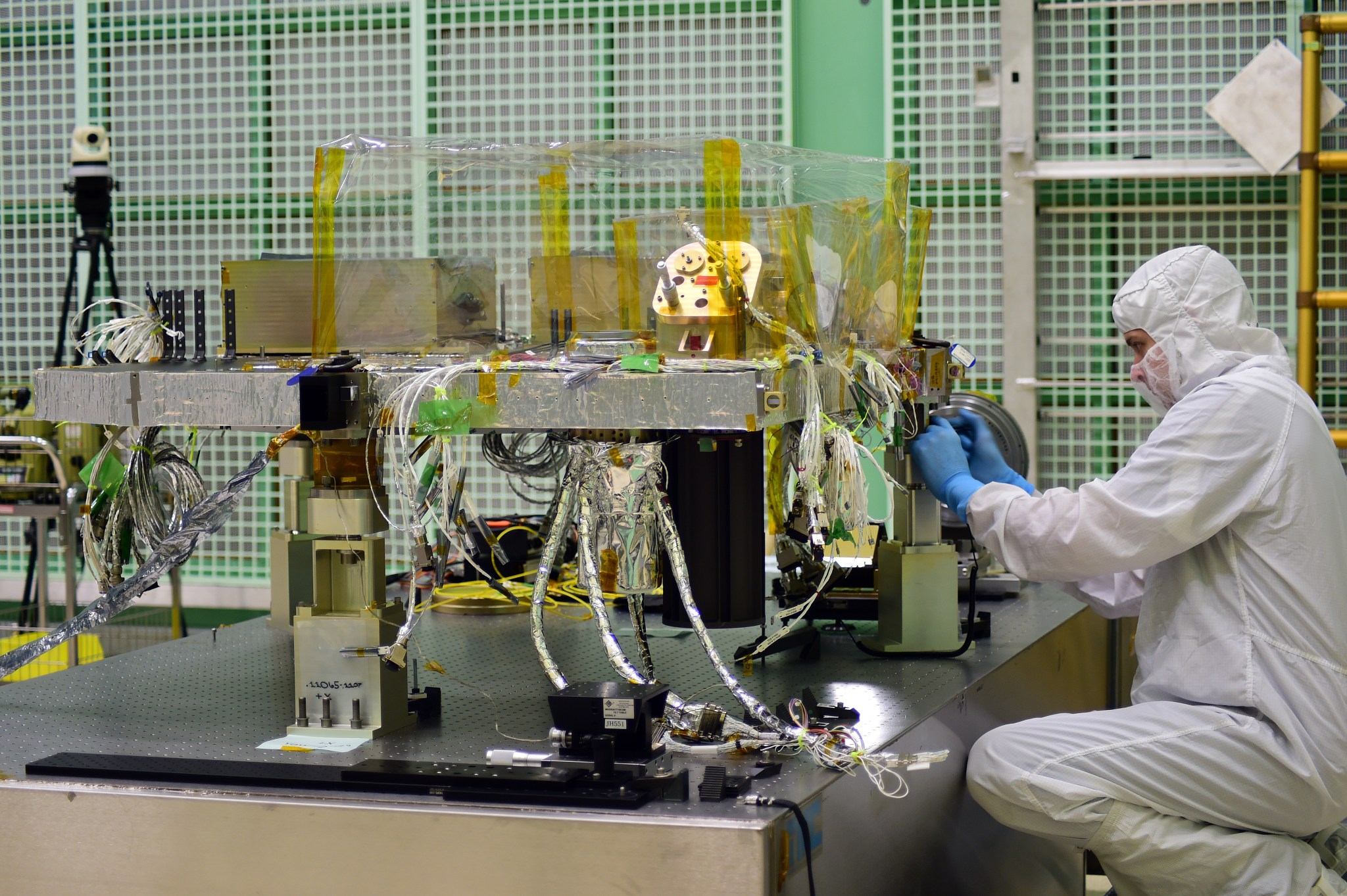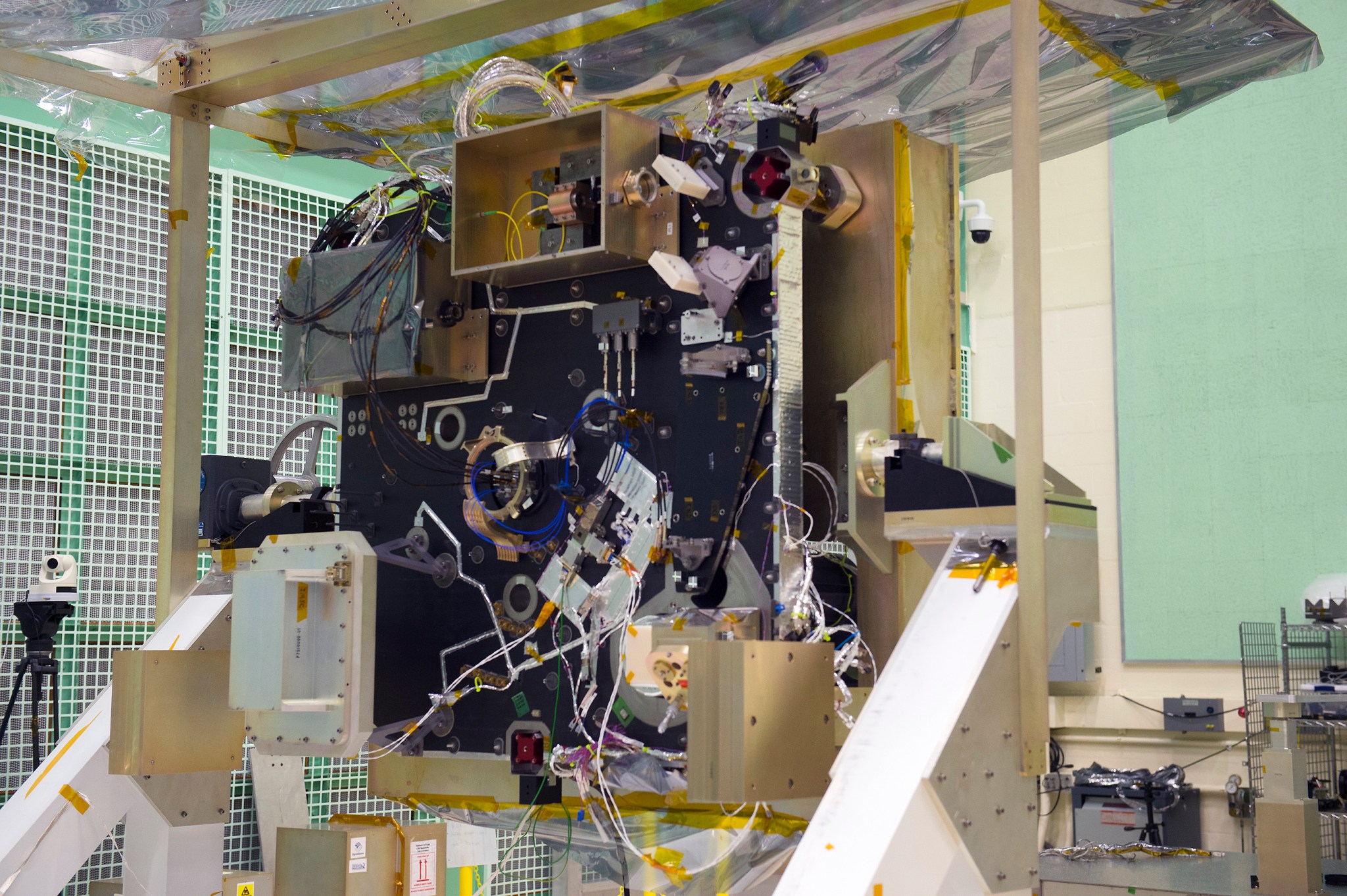Before beaming 300 miles to Earth’s surface, bouncing off the ground and travelling another 300 miles back into space, the laser photons on NASA’s Ice, Cloud and Land Elevation Satellite-2 first have to complete a 7½-foot obstacle course inside the satellite’s instrument.
The laser is the heart of ICESat-2, and essential to the satellite’s mission to measure the height of Earth’s surface, from ice sheets to forest canopies. The satellite’s instrument, called the Advanced Topographic Laser Altimeter System (ATLAS), has three major tasks: Send pulses of laser light to the ground, collect the returning photons in a telescope, and record the photon travel time. With this travel time, and the satellite’s position and orientation in space, scientists can calculate the height of Earth below ICESat-2.


First, the laser light has to leave the instrument. And it has to do so at the right frequency, while pointing in the right direction, starting the stopwatch in the process. ATLAS’s optical bench – a level platform that holds the mirrors, lenses and laser in place – makes sure that happens.
Line up the lasers
ATLAS, which is being built at NASA’s Goddard Space Flight Center in Greenbelt, Maryland, carries two lasers on the optical bench – one primary and one backup. The laser light is at 532 nanometers, a bright green on the visible spectrum. It is fast-firing, sending 10,000 laser light pulses per second. With this pulse rate, ATLAS can take measurements every 2.3 feet along the satellite’s ground path.
The first step on the laser’s path to the ground is just a few inches past the laser, where a fold mirror directs the light 90 degrees around a corner, where it hits the first key component, the Polarizing Beam Combiner.
The Polarizing Beam Combiner has two jobs. The first is to make sure that the primary and backup lasers head down the same path. Although the two lasers won’t fire at the same time, the laser beams begin at different positions and need to end up at the same place.
The second job is to use a periscope to pick off a fraction of the laser light and direct it to the Laser Sampling Assembly.
“This is a convenient place to do it because the Polarization Beam Combiner is always going to leak some light,” said Luis Ramos-Izquierdo, optical systems engineer at Goddard. “We’re using the leakage that we would have had any way, and we’re making use of it. We sample it, and it goes through fibers to different detectors.”
A sample of photons
At the Laser Sampling Assembly, one of these fibers starts the ’stopwatch’ for that photon pulse. This timing component has to be incredibly precise to get the measurements that scientists need – when a photon returns, its travel time is recorded to the billionth of a second.
The Laser Sampling Assembly also uses the small fraction of the laser to measure the laser’s wavelength, ensuring it remains precisely at 532.272 nanometers. This specific shade of bright green is what the filters on the receiving telescope let pass through to stop the stopwatch, once the laser pulse completes its journey. Any other wavelength gets filtered out as background noise.
As the Laser Sampling Assembly starts the timer, the rest of the laser pulse continues to the Beam Expander.
Shaping and steering the beam
The Beam Expander consists of two mirrors, facing each other but slightly angled so that the laser hits one, bounces across to the second one, and then continues on in the same direction. These mirrors are curved to make the laser beam more than four times wider once it bounces off them. Making the beam wider actually makes the photons diverge less as they travel to Earth, tightening the laser footprint on the ground and allowing for a more precise map of surface heights.
“The spot diameter on Earth’s surface would have been 66 meters, now it’s 15 meters,” Ramos-Izquierdo said. “By making the laser beam bigger in diameter before exiting the instrument, we actually decrease how much it spreads as it propagates downward through the atmosphere.”
The wider laser beam now goes through the Beam Steering Mechanism, which directs the laser at the ground below, but also has fine control over where the laser is pointing. This mechanism is connected with components on the instrument’s telescope receiver, which collects any photons that return. The goal is to automatically point the lasers at the exact spot on the ground, where the telescope is observing. If the telescope and laser are pointed at different spots, the Beam Steering Mechanism will make slight adjustments to correct the alignment.
The Beam Steering Mechanism is key because as the satellite goes in and out of the sun, changes in temperature could slightly warp the optical bench, said Tyler Evans, ATLAS optical engineer.
“You don’t want to have the laser light pointing to warp as well, so we have a motorized mirror to be able to steer that beam so it’s always pointing in the same direction no matter what happens to the optical bench,” Evans said.
Split in six
The last hurdle for the laser beam is the Diffractive Optic Element, on the far side of the beam steering mechanism. This optical component is etched with a microscopic pattern of crisscrossed lines, which splits the single laser beam into six. The beams are set at slightly different angles, so they will cover the ground in a specific formation of three pairs of beams.
“It changes the phase of the beam,” Ramos-Izquierdo said. “If you were to hit a linear grating, you would get a line of beams. So it’s a complex grating, in two dimensions, to get six spots.”
Once through the Diffractive Optic Element, the photons – lined up perfectly in six beams – are off on their journey to Earth.
For more information about ICESat-2, visit: http://icesat.gsfc.nasa.gov/icesat2/
























